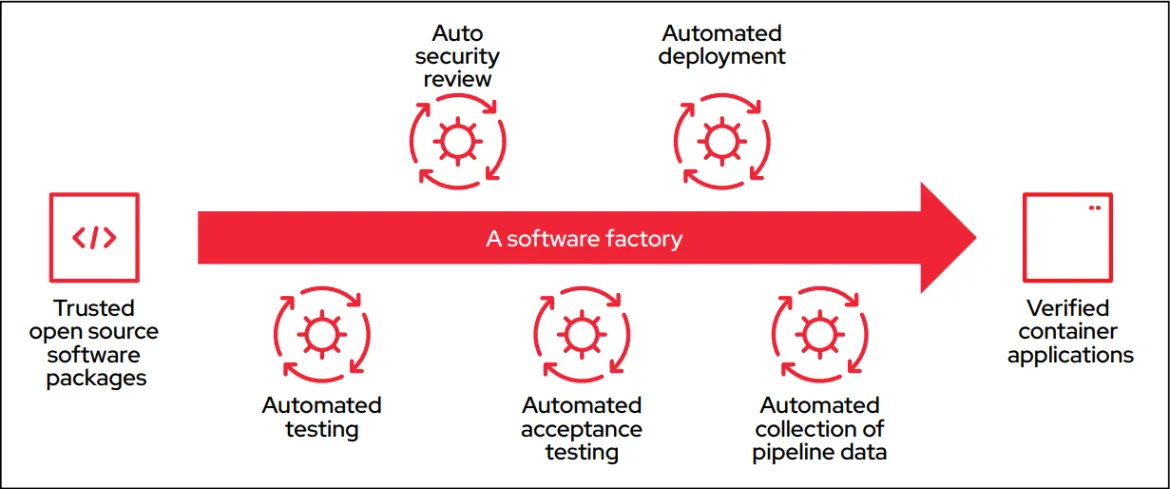Benefits of building a software factory with Red Hat OpenShift
The modern software supply chain
Most companies in today’s digital world have a software supply chain–the processes, tools, and platform that support developing, deploying, and updating software. This includes 3 inputs and outputs:
- Runtimes. Used to support products, tools, and components for developing and maintaining cloud-native applications.
- Assembly. The focus is on building, testing and securing applications.
- Production. This addresses the delivery of finished software applications.
An effective software supply chain is supported by a software factory.
What is a software factory?
Modern software delivery relies on speed, consistency, and quality. A software factory is part of a modern software supply chain and supports, accelerates, and enforces the behavior changes that organizations need to adopt a DevSecOps culture. A software factory is the digital equivalent of an assembly line, but instead of physical parts, assembly robots, and quality checks, it has multiple software pipelines, which are equipped with a set of tools, process workflows, scripts, and environments to produce consistent, reliable cloud-native applications with minimal human intervention.
A modern software factory supports velocity.
Remove manual processes that restrict software development and deployment
Developing and deploying high-quality software at scale while adhering to security and compliance requirements is a challenge for many organizations. Manual processes and sign-offs create inconsistent security practices and result in slower, less controlled software delivery. The lack of consistent or transparent processes leads to inefficient work and distrust between teams. The more complicated the implementation, the more distracted developers become by tangential issues. Building applications with manual processes is less productive than the alternative: a software factory approach.
Security and compliance concerns arise late in the project, adding more friction to an already stressful phase. These concerns can be solved earlier in the process by focusing on adding security software components and dependencies early in the software development life cycle and using DevSecOps practices to automate the integration of security at every phase. Once deployed, applications need to be continuously monitored, to detect and alert on any changes to their risk profile including vulnerability and exposure. Adopting a software factory approach connects teams to opinionated, consistent, and automated developer and operations workflows. Teams can work with a trusted software supply chain and enforced sequence.
Boost the speed of development and deployment with quality and consistency
In a software factory, the develop, build, test, release, and deliver phases are automated to help teams ship updates consistently and with increased security.1 Automated phases with a software factory include:
- Testing
- Security review
- Acceptance testing
- Deployment
- Collection of pipeline data
A modern software factory shifts your perspective from project to product focus.

Organizations that have implemented a software factory can ship software with fewer defects in less time, and can get applications to market over 95% faster and at higher quality2 (see Figure 1).
What you need for a software factory
Unlock the power of technology such as containers and Kubernetes while minimizing complexity.
- Standardize on a security-focused platform.
- Support automation and consistency.
- Use automation to drive speed to market while increasing stability.
- Build a consistent pipeline.
Table 1. The impact of software factory
| Software delivery performance metric | With a software factory | Without a software factory |
| Deployment frequency | On-demand (multiple deployments per day) | Once every 1-6 months |
| Lead time for changes | Less than 1 hour | 1-6 months |
| Time to restore services | Less than 1 hour | Between 1 day and 1 week |
| Change failure rate | 0%-15%3 | 16%-30%1 |
Accelerate time to market while maintaining consistency
A software factory approach helps organizations shift from a project to product focus and gain greater trust in the software pipeline. Increasing stability and using automation boosts speed to market. Small changes can be rolled out in minutes with quality by default, helping developers to focus on coding and innovating.
Bring security to your applications by ensuring that only trusted open source software and containerized images are used during the development and build phases with documented processes and policies to help teams gain clarity on expectations and prevent surprises. Feedback is immediate, speeding up how much sooner changes can be deployed daily while reducing risk.
For all the benefits of a software factory approach to work for an organization, a security-focused platform that supports automation and consistency is key. Red Hat® OpenShift® helps organizations adopt this approach by providing a single hybrid-cloud platform for enterprises to build, deploy, run, and manage intelligent applications with hardened security at scale.
Red Hat OpenShift helps companies unlock the power of containers and Kubernetes, while reducing the complexity of adopting these technologies. That lets you focus on what matters most—getting your applications to market first and being best in market by promptly responding to your customers’ needs.
Get started with Red Hat OpenShift Platform Plus and adopt the benefits of a software factory approach.
Forrester. “Total Economic Impact Of Red Hat OpenShift Plus.” January 2023.
Red Hat customer story. “Asiakastieto unlocks open banking innovation with Red Hat.”May 2020.
Google Cloud. “Accelerate State of DevOps 2021.” September 2021.